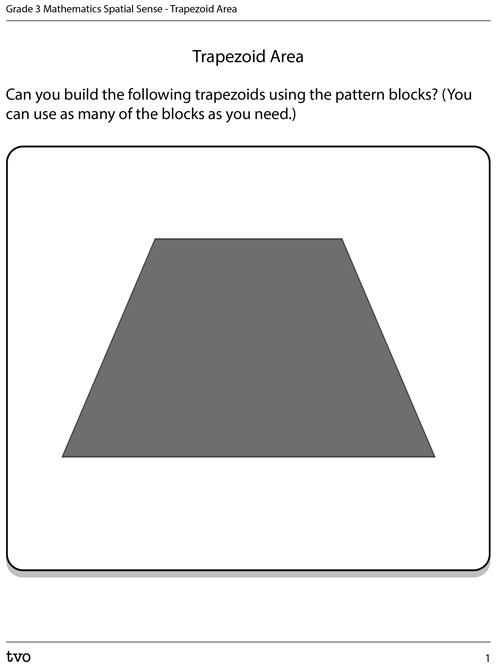Minds On
Comparing area
Area is the amount of space inside a two-dimensional shape.
The area of one shape can be directly compared to the area of another shape by covering and matching the areas to determine which is larger.
Examine the following two rectangles. Which rectangle do you think has a greater area? Why?

Action
What is area?
Area is the space inside a shape.
Area is measured by counting how many units it takes to cover the space inside.
To calculate the area, the units must all be congruent: the same shape and size.
A unit is the object or shape used to cover the space inside a shape to determine area.
Finding the right unit
Anything can be used as a unit, but some shapes work better than others.
Imagine that a designer wants to find the area of a hexagon.

The designer decides to use circles as the unit. They carefully fill the hexagon with circular counters.

Brainstorm
What’s the problem?
Use the method of your choice to record your ideas.
- If the designer counts up the circles in the hexagon, will they have an accurate measurement of its area?
- Will the area measured be too low or too high? Explain your thinking.
Press the ‘Hint’ button to find out if you’re on the right track.
Perhaps the solution is for the designer to place the counters very carefully to make sure there are no gaps between them.

Brainstorm
What’s the problem now?
Use the method of your choice to record your ideas.
- Imagine that the designer fills the whole hexagon with overlapping circular counters. If they count up the counters, will they have an accurate measurement of its area?
- Will the area measured be too low or too high? Explain your thinking.
Press the ‘Hint’ button to find out if you’re on the right track.
Pattern blocks rock!
Pattern blocks can be used to measure area.
When measuring area using pattern blocks, you want to know how many of one type of block it would take to fill the area with no gaps or overlaps.
That block is called the unit.
Let’s try to measure the area of a hexagon again. This time, we’ll use pattern blocks.
We can describe the area of the hexagon using a full hexagon pattern block itself or other pattern blocks.
For example, the area of a hexagon could be 6 triangles, or 3 rhombuses, or 2 trapezoids, or 1 hexagon.
The units inside a shape can be moved or turned.
As long as there aren’t any gaps or overlaps, there will always be the same amount.
For example, a hexagon will always have an area of exactly two trapezoids or three rhombuses. It doesn’t matter how they are arranged.

Creating polygons with pattern blocks
Use pattern blocks or shapes to create a series of polygons or designs (hexagon, square, rhombus, triangle, trapezoid).
You can use blocks if they are available or provide a detailed description of the shapes you want to make.
How many ways can you create the same design using different shapes? For example, if someone was designing a flower, they could use a hexagon or six triangles or two trapezoids as the flower.
Brainstorm
Think about how you used your blocks
Record your thinking about how you used your pattern blocks digitally, orally, or in print.
Answer the following questions as you review your work.
- Did you fill in your polygons with different shapes?
- When using pattern blocks to measure area, which shape(s) were the best to use so you didn’t have overlaps?
- When using pattern blocks to measure area, which shape(s) were the best to use so you didn’t have gaps?
Your turn
Let’s practice building trapezoids. The following image displays three trapezoids.
Can you build these trapezoids using the following pattern blocks? (You can use as many of the blocks as you need.)



Record your thinking using a method of your choice. If you’d prefer, you can use the following printable “Trapezoid Area” document to experiment with the pattern blocks.
When you are ready, press the ‘Answers’ button to reveal some possible solutions.
The following are some possible pattern block arrangements for the trapezoid.
To build the first trapezoid, 5 isosceles triangle pattern blocks were joined together. Therefore, the area of this trapezoid is 5 triangles.
To build the second trapezoid, 4 right triangle pattern blocks were joined together. Therefore, the area of this trapezoid is 4 right triangles.
To build the third trapezoid, 4 smaller trapezoid pattern blocks were joined together. Therefore, the area of this trapezoid is 4 smaller trapezoids.
Consolidation
Task 1: Creating solutions
Two students were trying to calculate the area of the following shapes.

Use what you have learned about how to accurately measure area of a shape to explain the steps they could take to calculate the area of the shapes.
Can you explain two different ways they could calculate the area?
Record your thinking using a method of your choice.
Press the ‘Hint’ button for a helpful tip.
Task 2: Different shapes, same area
Draw two polygons with five or more sides that have similar areas.
Each polygon must have an area of between 20-25 square units.
Use a geoboard or a method of your choice to create your polygons.
Think about your learning
Why was it important that there aren’t gaps between units when measuring area?
Why was it important that the units don’t overlap when measuring area?
Reflection
How do you feel about what you have learned in this activity? Which of the next four sentences best matches how you are feeling about your learning? Press the button that is beside this sentence.
I feel...
Now, record your ideas about your feelings using a voice recorder, speech-to-text, or writing tool.
